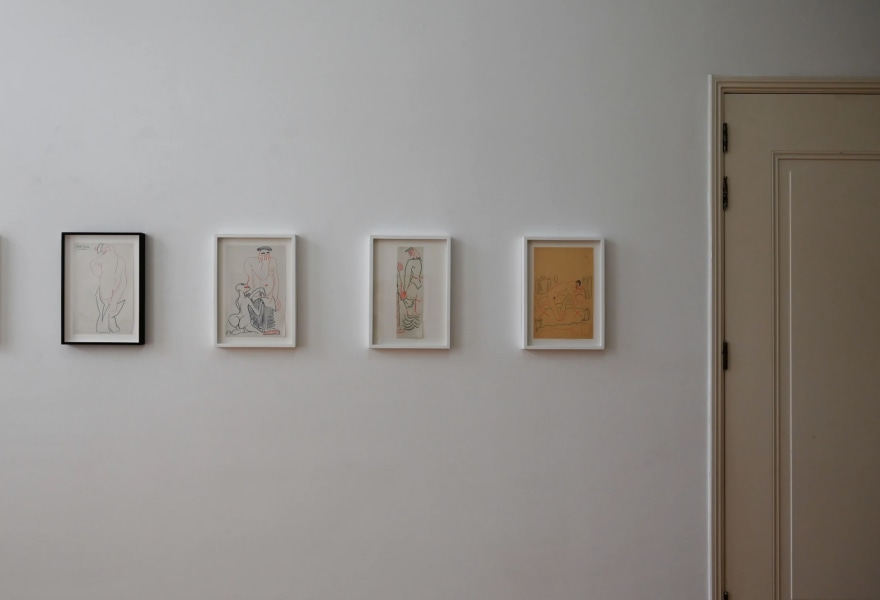19 july 2024, Wouter van den Eijkel
Sergei Eisenstein - The rhythm of ecstasy
Ellen de Bruijne Projects currently has a unique exhibition featuring the secret homoerotic drawings of Sergei Eisenstein. The drawings shed new light on the work and underlying ideas of the pioneering director.
Generally speaking, summer exhibitions are an extension of an ongoing show or collection of works around a theme by the gallery's artists. Occasionally, a gallery owner presents something special. Ellen de Bruijne does exactly that. In collaboration with London's Stephenson Art, a selection of the long-hidden, homoerotic drawings of Sergei Eisenstein are on display at the Singel.
You read it right: Sergei Eisenstein. That Sergei Eisenstein. Director of Battleship Potemkin (1925), renowned for his groundbreaking montage technique and the Odessa Steps sequence, October (1928) and Ivan the Terrible (1944). (Riga, 1898 – Moscow, 1948) drew throughout his life, but did not consider his drawings to be art. They often served as studies for film scenes or to flesh out ideas. On his death in 1948, around 4,500 drawings were acquired by the Soviet Union. The drawings on display at De Bruijne were never handed over, as their subjects were too incriminating for Eisenstein personally.

Sergei Eisenstein, Untitled, 1940, Ellen de Bruijne Projects
Some drawings can be interpreted as political commentary, but most depict homoerotic scenes. In Tsarist Russia, homosexuality was not socially accepted, though not legally prohibited. That changed under Stalin. It is a miracle that around 500 drawings have survived. Eisenstein’s wife—he married his confidante and secretary Pera Atasheva—gave them to cameraman Eduard Tisse, whose children sold them to the current French owner in the late '90s. These drawings cast a new light on the filmmaker's oeuvre.
Visual diary
In retrospect, you might read the drawings as a visual diary because Eisenstein never signed them, but always dated them. Sometimes, he depicted current events. For example, there is a drawing of a soldier with a wooden leg with the word ‘Berlin’ on the foot, dated ‘the second day’. That would be 21 April 1945, the day after the Russians crossed the Oder, making Berlin a frontline city.
More often, his drawings reveal subjects that preoccupied him. In September 1942, he made the drawing Drag New York and signed it with AA, which stands for Alma Ata, where he was working on Ivan the Terrible at the time. It is a drawn memory of a drag show he saw in Harlem in 1930. Twelve years later, it still occupied his thoughts while in the Kazakh capital.

Sergei Eisenstein, Untitled, 1942, Ellen de Bruijne Projects
No wasted time
A year earlier, in 1929, Stalin asked Eisenstein to research the possibilities of the new talking picture abroad. Eisenstein was invited to Hollywood by his colleagues from United Artists, but the trip was delayed for political reasons. As a result, Eisenstein first had to travel through Europe for half a year, attending premieres of his films, giving lectures and meeting with artists, writers, and intellectuals. He also visited Antwerp and Amsterdam.
It turned out to be far from wasted time. The four years he ultimately spent outside the Soviet Union were intellectually and personally formative and fruitful. The essay that curator Sergi Rusca wrote for the exhibition describes how Eisenstein's thought process developed during those years. In Berlin, for example, he studied the latest publications on anthropology and sexology and visited well-known transvestite bars. The same goes for Paris, where he also befriended Jean Cocteau, who stylistically influenced him. It is also in Paris where he acquired many ideas about ‘sensory thinking’ and ‘pre-logical ways of consciousness’. These non-normative ways of thinking undermine the heteronormative status quo.

Sergei Eisenstein, Untitled, 1931, Ellen de Bruijne Projects
Via New York, Eisenstein ended up in Hollywood in the spring of 1930, where he spent time with Charlie Chaplin and Walt Disney. The plan was to make films for Paramount. That never happened because an anti-Soviet and anti-Semitic wind blew in the press and politics. Later that fall, Paramount cut ties with Eisenstein.
Just before Eisenstein was to return to Russia, he met with the Upton and Mary Craig Sinclair, a wealthy leftist pair willing to finance his next project. Que viva México! was to be a dramatized documentary covering, among other things, the melting pot of religions. Eisenstein eventually stayed in Mexico for 14 months, shot more than 40 hours of film, but it was primarily here where he drew non-stop and had his first affair with a man. It was also where he could probably be most himself during his life. In a letter to his secretary and later wife, he wrote that he was experiencing life for the first time ‘without evaluating it’.
The drawings he made in Mexico are undeniably queer, not only because they depict homosexuality, but also due to the underlying ideas and humour. According to Eisenstein, bisexuality was a natural state before people became sexually mature. In adulthood, bisexuality was an expression of the desire to escape binary oppositions and fixed expectations and identities. This state would provide ecstasy that bypasses the split between body and mind. According to him, the same effect was achieved through montage techniques in film.
Meanwhile, filming in Mexico was not progressing. Deadlines were missed and disputes arose between the Sinclairs and Eisenstein. The conflict escalated to the point where the Sinclairs filed an official complaint with Soviet officials about Eisenstein's homosexuality and his homoerotic drawings. Consequently, Stalin ordered Eisenstein to return to Russia. His Mexican film never saw the light of day and the drawings remained in a folder under his bed.
Sergei Eisenstein – The rhythm of ecstacy: the sex drawings, 1931-1948 can be seen at Ellen de Bruijne Projects in Amsterdam until 4 August.

Sergei Eisenstein, Untitled, 1940, Ellen de Bruijne Projects
